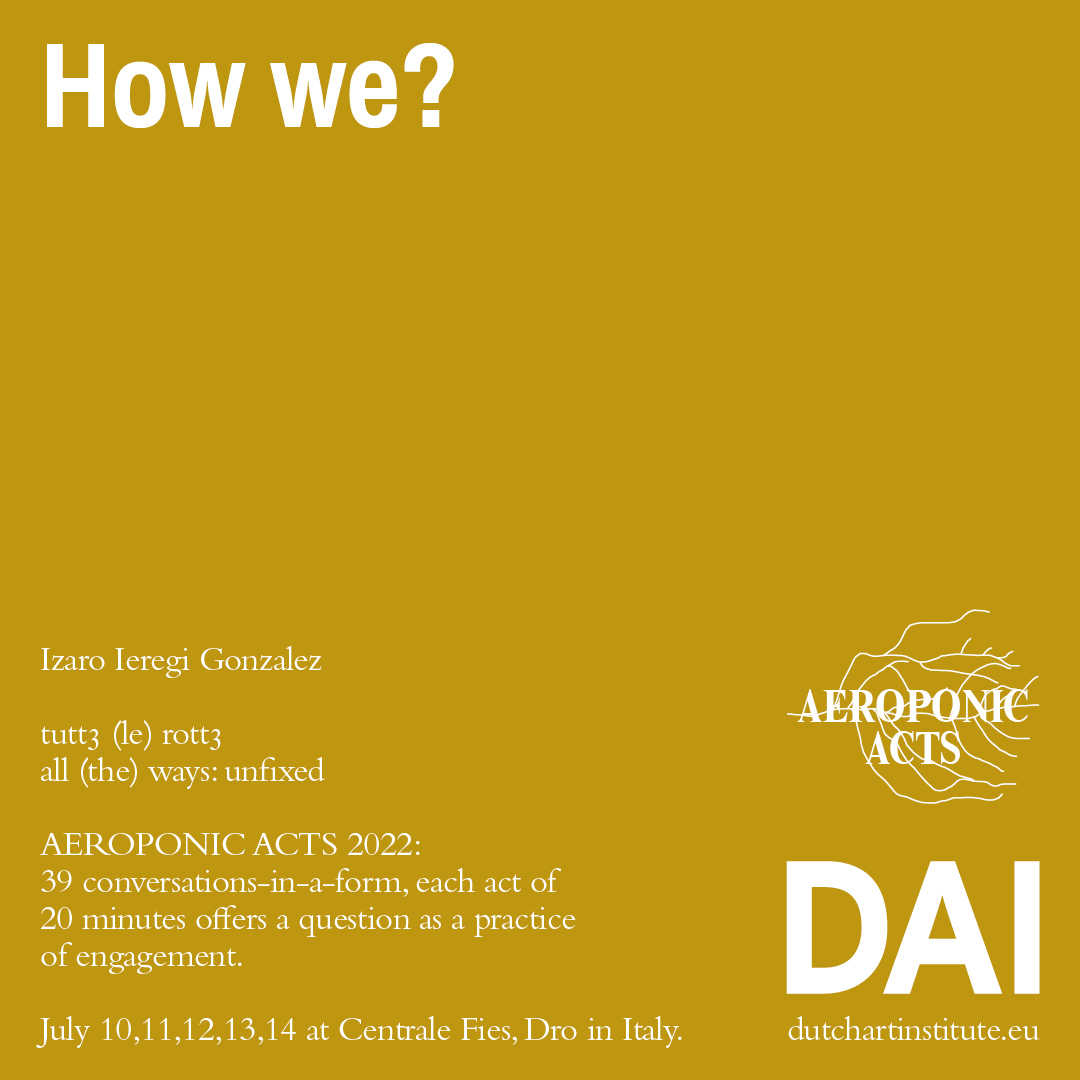Izaro Ieregi Gonzalez: Conjugate one to each other
’Aeroponic’ – root systems nourished by air – Acts is the name given to the nomadic Dutch Art Institute’s final Kitchen presentations. Each participant addresses one question, as a practice of engagement.
Here you will find the documentation of Izaro Ieregi Gonzalez's presentation as filmed by Baha Görkem Yalım. The written report is by Hubert Gromny and it includes a summary of the comments by esteemed guest respondents.
Conjugate one to each other
Izaro's question: How we?
Izaro's introduction: Thinking about the sculptural potential of the performance, space, bodies and time are put in relation. A place of changing gravity is drawn where bodies and objects undulate. A place to reflect poetically on failure, shame and love. Invoking the ability to articulate a new world from the fragility of our existence.
An exercise to conjugate one to each other;
Body; To body.
with Dylan Spencer Davidson (DAI 2022), Eli Witeman (DAI 2022) , Liza Rinkema Rapus (DAI 2022) , Iarlaith NiFeorais (DAI 2023) , Ros del Olmo (DAI 2023), Maoyi (Peixuan) Qiu (DAI 2022), Isabelle Weber (DAI 2022), Nadja Henss (DAI 2022), Vera Mühlebach (DAI 2022), Adriana Leanza (DAI 2023), Hanah Jones (DAI 2022), Iga Świeściak (DAI 2022) and Gleb Maiboroda (DAI 2023).
Hubert's report: Audience enters a bright space. In the middle on the floor a mixer is located with five long cables sprouting in different directions, connecting them to microphones. Red spotlights accentuate the mikes lying on the floor. A group of performers is disseminated around the emphasized spots. After the audience settles in the space, performers engage with bodies of each other in various ways. Some of which resemble acrobatic contact improvisation, others are more simple like lying and sitting on top of the other person, carrying, pushing or walking along. Isaro is present with the performers, who gather into one big group and create a sculptural shape out of their collective body. Once the shape of the group is being articulated individual performers reach out to the microphone and give short speeches or engage in dialogues with each other. The performance unfolds with the group crawling, carrying and dragging itself to other red spotlights and engaging with microphones—the speech becomes more conversational. Towards the end performers directed by Isaro attune with each other and speak almost in a chorus. The performance ends with the collective body forming a line in which all performers are facing the audience.
Momtaza Mehri evoked her first impression after entering the space, as feeling invited to freely find her place in the space poetically constructed with the use of microphones, lights and cables, and later by the way the mics were used to speak, and by the movement of the irregular pyramid of bodies shoving itself in the room. The dissociative language of the performed text was another mode of creating an open and inviting space for the audience—in a very literal way these spaces were created by the moments of silence, which incorporated sounds generated by accidentally moved and rubbed microphones.
Phanuel Antwi referred to the question of the presentation and commented on the recurring question of who and how the collective, the “we” is being constituted—how an assembly of people constitutes itself as a “we”? The way Isaro and the group were moving through five different locations in the space created a certain kind of mapping and a certain kind of geography. In this geography one could see how units are coming together in conjugation in terms of language. Conjugation in a present continuous tense describes how the movement which preceded each formation needed to be reformulated continuously throughout the motion. Another aspect Phanuel highlighted was the way participants held each other, which reflected on the interdependence between them. Phanuel noted that the performance offered much more than observing the bodies changing positions, it did allow audience to see how much commitment and dedication is required to create forms of togetherness.
Chiara Figone observed that the piece created a space of interdependence in which each body was relying on the other. The dynamics between bodies pushing and pulling each other were reflecting on the attempts and modalities of creating a collective body without creating a structure of power. How do we create spaces for our bodies to be comfortable without forgetting bodies which support and sustain us? This is how the question of dependency arised in the performance and has to be completed with the question of relationship based on care. That the constructions built by bodies were almost immediately disintegrating during the presentation created an interesting space to think of togetherness based on hope for forms of being together which assume the possibility of failure.
Izaro Ieregi Gonzalez's "Conjugate one to each other" was presented before live audience at the Centrale Fies, Dro, Italy on July 13th.
Find the overview of all 24 AEROPONIC ACTS 2022 here:tuttə (le) rottə - all (the) ways: unfixed
About Izaro Ieregi González


